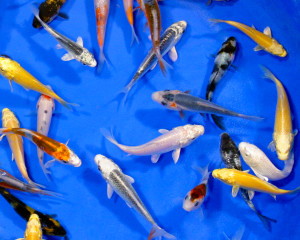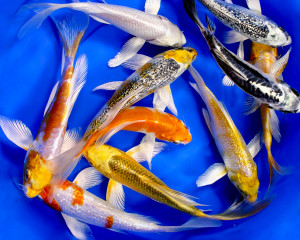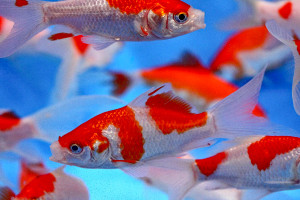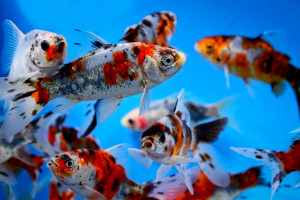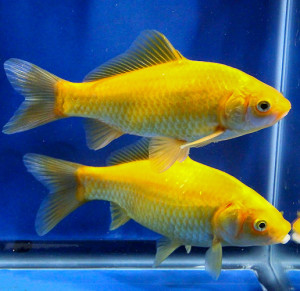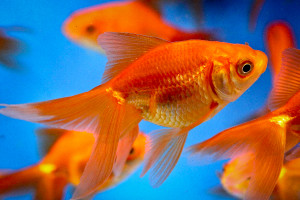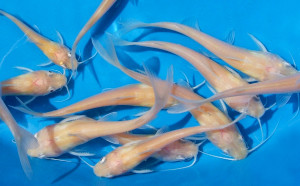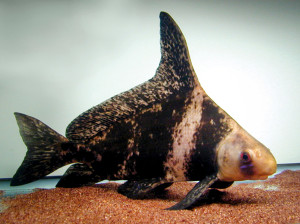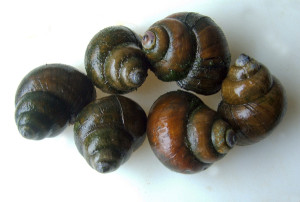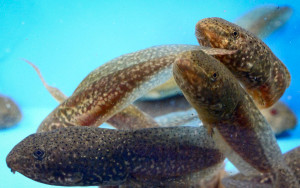What Fish Can I Add to My NJ Fish Pond, you ask…
A well balanced pond environment is easily maintained with equal parts of animal and plant life. Plants have started to bud, and produce foliage at an incredible rate with the warm spring sun we have recently been doused with. But what if a harsh winter or hungry predator was the catalyst to your fish friends disappearing? Animal life in your pond is a key element to continuing a functioning mini ecological system. Here are some types of friends you can easily find and easily care for in our neck of the woods.
Standard Koi: Standard refers to the fin type of this easy to care for fish. A typical dorsal fin on the spine, and two on the sides propel this fish through the water. Coloration and size determine their grade and their cost. Can be found as small as 3 – 4″ in length and can grow to 24″ long and bigger!
Butterfly Koi: Butterfly refers to the fin type of this beauty. Free-flowing wing-type fins on both sides, as well as its tail offer movement throughout your pond. Bright vibrant colors and varieties will determine their cost. These pretty friends can be found as small as 3 – 4″ in length and can also grow upwards of 24″.
Goldfish (Including Sarasa and Yellow Comets, Shubunkins, and Fantails): These are all varieties of Goldfish and lucky for us they are all hardy to our winters, with proper pond depth and preparation. Goldfish can tend to be avid eaters, producing pretty significant levels of waste, so proper filtration in their home is key to their success. Goldfish are typically found at an entry level size of 5 – 6″ and can get to about 20″ in length, depending on variety. They are a great starter fish to any pond.
Albino Channel Catfish: These bottom movers are typically available in an entry size of 4 – 6″ and can get quite large, up to around 20″ and longer! As their name suggests, they have a white appearance as compared with their darker colored relatives the blue channel catfish. They tend to favor the bottom half of your pond, as most catfish bottom feeders do. Don’t be fooled though, they will certainly find their way to the surface for feedings and daily visits to say hello.
Hi Fin Banded Shark: Want to see your friends and family go bonkers? Tell them you just brought a shark home! Although they resemble them in stature, the Hi Fin Banded Shark has no genetic connection to the sharks we see on Animal Planet today. They can get quite large in the right conditions, 3 feet to be exact. Happy to troll the bottom of their home and munch on mostly vegetation, these prehistoric little guys are slow growers and prefer cooler waters. Their contrasting colors, or banding, is best seen when they are young, so the smaller the shark the brighter the colors. As they get larger the contrasting fades a bit as they get comfortable sucking algae from the bottoms of rocks and logs. The drastic sloping dorsal fin adds beautiful contrast to any pond, large or small.
Trapdoor Snails: These algae eaters act as a built-in cleaning crew to the sides of their environment. In fact they steer clear of fish eggs and plants, making them the Switzerland of aquatics pets. Adaptable to fluctuating pH levels, and preferring silty or sand bottoms, trapdoor snails will make it through some of the mucky slow-moving waters of larger natural ponds, as well as smaller ponds. Though not indigenous to our geographical area, they are now found in most local rivers and small streams making them easy to harvest and an inexpensive addition.
Bullfrog Tadpoles: One of the coolest miracles of the natural world is seeing a tadpole morph from an all-tail squirmer to a hopping frog! The phases and changes in between are something that sound more sci-fi than natural, and something that we may take for granted, but when you have the pleasure to witness it, seems to be such a seamless process. Bullfrogs when mature are some of the largest frogs in the world, and can live in good conditions for years. Up to 10 in some areas! Upon maturation, they are not exactly particular about their diet. Anything will do including plants and animal life so be mindful of smaller fish in your pond.
Before adding new friends, there are a few steps to complete and conditions to confirm for their safety. Always always always have your waterfall and/or circulation pump running, and do not turn it off for anything other than routine maintenance. Oxygen is the most important element for all of our aquatic friends. Water temperatures are also a key element to survival. The water in the container they are brought home in differs drastically in composition and temperature than the water in your pond at home. The best way to acclimate is to temper the change. Floating the bag of new friends in their new home for about 20-25 minutes will ensure they have been gently introduced to your water. As for the release of your new friends, place only the animal into your pond and be sure to dump the bag water anywhere but into their new home. Their journey home included producing waste making the container water quite toxic. Adding that water to your well balanced environment is simply unnecessary and can do more harm than good.
Visit us again for more information, ideas, and inspiration at afrogsdream.com
A Frog’s Dream Aquatic Services is offering this blog as a personal information source to our website visitors. Pond services are performed in Morris County New Jersey (NJ) Hunterdon County New Jersey (NJ) Somerset County (NJ) and Warren County (NJ).Waterfall ponds, Streams, and Fountains are all in our wheelhouse of talent. Explore our website for more ideas. Like our Facebook page for daily inspiration. Receive our newsletter for monthly tips and a coupon or two.

